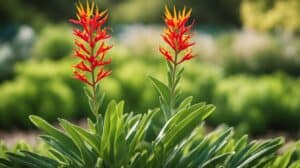String of Hearts, also known as Ceropegia woodii, is a popular trailing plant that is easy to care for and perfect for beginners.
This plant is native to South Africa and is often grown as a houseplant in other parts of the world.
Its unique heart-shaped leaves, delicate vines, and charming appearance make it a popular choice for indoor gardening enthusiasts.

Ceropegia woodii is a low-maintenance plant that can thrive in a range of indoor conditions.
It requires minimal watering and can tolerate low light, making it an ideal choice for those who are new to indoor gardening.
With proper care, this plant can grow up to several feet long and add a touch of greenery to any room.
In this beginner’s guide, we will explore the basics of growing String of Hearts indoors, including its ideal growing conditions, propagation, and common issues that may arise.
Understanding Ceropegia Woodii
Species Overview
Ceropegia woodii is a trailing vine that is native to South Africa.
It belongs to the family Apocynaceae and is commonly known as String of Hearts due to its heart-shaped leaves.
The plant produces small, tubular flowers that are typically shades of pink and maroon.
It is a popular houseplant due to its attractive appearance and ease of care.
Common Names
In addition to String of Hearts, Ceropegia woodii is also known by several other common names, including Chain of Hearts, Rosary Vine, Hearts Entangled, and Sweetheart Vine.
These names all refer to the plant’s heart-shaped leaves and trailing growth habit.
Historical Significance
Ceropegia woodii was first described by John Medley Wood in 1881. The plant’s specific epithet, woodii, is named after him.
The plant has been cultivated as a houseplant for many years and has become increasingly popular in recent years due to its unique appearance and ease of care.
It is often used in hanging baskets or as a trailing plant on shelves or windowsills.
Cultivation Basics

Lighting Requirements
String of Hearts plants require bright, indirect sunlight to thrive.
Direct sunlight can damage the leaves, so it’s best to place them near a window that receives filtered light or to use a sheer curtain to diffuse the light.
If the plant starts to stretch or become leggy, it’s an indication that it needs more light.
Watering Techniques
Overwatering is the most common mistake when it comes to growing String of Hearts.
These plants prefer to dry out between waterings, so it’s best to let the top inch of soil dry out before watering again.
When watering, make sure to saturate the soil thoroughly and allow the excess water to drain out of the pot.
It’s also important to avoid getting water on the leaves, as this can lead to rot.
Soil and Potting Mix
String of Hearts plants prefer well-draining soil that is rich in organic matter. A mix of potting soil, perlite, and sand is a good option.
When repotting, it’s important to choose a pot that is only slightly larger than the current one, as these plants prefer to be slightly root-bound.
Temperature and Humidity Control
String of Hearts plants prefer temperatures between 60-75°F (15-24°C).
They also prefer moderate humidity levels, so it’s important to avoid placing them near heating or cooling vents.
If the air in your home is particularly dry, you can increase humidity levels by placing a tray of water near the plant or by using a humidifier.
By following these basic cultivation tips, even beginners can successfully grow String of Hearts plants indoors.
Propagation Methods

Ceropegia woodii, commonly known as String of Hearts, is a popular houseplant that can be propagated through various methods.
Here are the three main ways to propagate String of Hearts: stem cuttings, leaf cuttings, and seeds.
Stem Cuttings
Stem cuttings are the most common method to propagate String of Hearts. To propagate through stem cuttings, follow these simple steps:
- Cut a healthy stem from the mother plant, making sure it has at least two nodes.
- Remove the leaves from the bottom half of the stem.
- Dip the cut end of the stem in rooting hormone powder.
- Plant the stem in a well-draining potting mix and keep it moist.
- Place the pot in a bright, indirect light and wait for the roots to develop.
Leaf Cuttings
Leaf cuttings are another way to propagate String of Hearts. This method is not as reliable as stem cuttings, but it can be a fun experiment.
Here are the steps to propagate through leaf cuttings:
- Cut a healthy leaf from the mother plant, making sure it has a stem attached.
- Cut the stem into several sections, each with a small piece of the leaf attached.
- Dip the cut ends in rooting hormone powder.
- Plant the leaf cuttings in a well-draining potting mix and keep it moist.
- Place the pot in a bright, indirect light and wait for the roots to develop.
Seeds
Propagation through seeds is the least common method for String of Hearts. This is because the plant rarely produces seeds indoors.
However, if you do have seeds, here are the steps to propagate:
- Sow the seeds in a well-draining potting mix.
- Keep the soil moist and place the pot in a bright, indirect light.
- Wait for the seeds to germinate and grow into small plants.
- Transplant the small plants into individual pots and care for them as you would the mature plant.
Overall, propagation is a great way to expand your collection of String of Hearts.
With a little patience and care, you can easily propagate this beautiful plant through stem cuttings, leaf cuttings, or seeds.
Care and Maintenance

Fertilizing Schedule
Ceropegia woodii is a low-maintenance plant that doesn’t require frequent fertilization.
However, to promote healthy growth, it is recommended to fertilize the plant once a month during the growing season (spring and summer).
Use a balanced liquid fertilizer diluted to half strength and apply it to the soil. Avoid fertilizing during the winter months when the plant is dormant.
Pruning and Training
String of Hearts is a trailing plant that can grow up to several feet long.
To keep the plant in good shape, prune it regularly by cutting back the stems to encourage branching.
You can also train the plant to grow in a certain direction by gently bending the stems and securing them to a support.
Pest and Disease Management
Ceropegia woodii is a relatively pest-resistant plant, but it can still be attacked by common houseplant pests such as spider mites and mealybugs.
To prevent pest infestations, regularly inspect the plant for signs of damage or pests.
If you notice any, isolate the affected plant and treat it with an insecticidal soap or neem oil.
In addition, overwatering can lead to root rot and other fungal diseases.
To avoid this, make sure to let the soil dry out between watering and avoid getting water on the leaves.
If you notice any signs of disease, such as yellowing leaves or wilting, remove the affected parts of the plant and adjust your watering schedule.
Frequently Asked Questions

What are the best practices for caring for a String of Hearts plant indoors?
Caring for a String of Hearts plant indoors involves providing it with the right amount of sunlight, watering it properly, and providing it with adequate nutrients.
These plants thrive in bright but indirect light, so placing them near a window that receives filtered sunlight is ideal.
They prefer well-draining soil and should be watered only when the soil has dried out completely.
Fertilizing the plant during the growing season can help promote healthy growth.
Can you explain the process of propagating a String of Hearts?
Propagating a String of Hearts plant is relatively easy and can be done through stem cuttings.
Simply cut a stem with a few leaves and nodes, and place it in a container filled with moist potting soil.
Keep the soil moist and place the container in a bright, indirect light. The cutting should start to root within a few weeks.
How often should I water my String of Hearts, and is top or bottom watering preferred?
String of Hearts plants should be watered only when the soil has dried out completely.
It is best to water them from the bottom by placing the pot in a container of water and allowing the soil to soak up the water.
This prevents the leaves from getting wet, which can cause them to rot.
What should I do if my String of Hearts plant is experiencing growth problems?
If your String of Hearts plant is experiencing growth problems, it may be due to a lack of sunlight or nutrients.
Move the plant to a brighter location and consider fertilizing it with a balanced fertilizer.
If the plant is root-bound, repotting it in a larger container with fresh soil can also help.
Are there any specific benefits to growing a String of Hearts plant in my home?
Aside from their ornamental value, String of Hearts plants are known for their air-purifying properties.
They can help remove harmful toxins from the air, making them a great addition to any home.
Does the String of Hearts plant produce flowers, and if so, how can I encourage blooming?
Yes, the String of Hearts plant produces small, tubular flowers in the summer.
To encourage blooming, provide the plant with bright, indirect light and fertilize it with a balanced fertilizer during the growing season.














